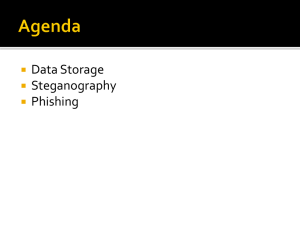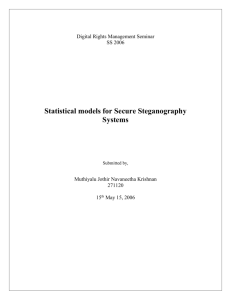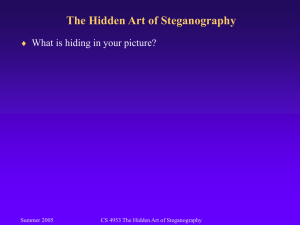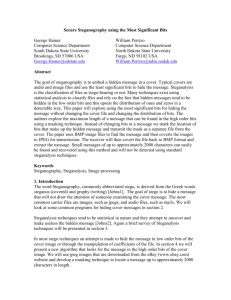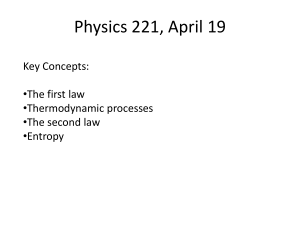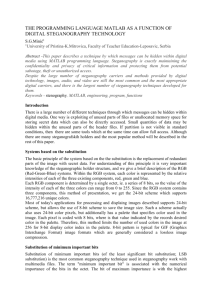A Brief Introduction to Information Theory
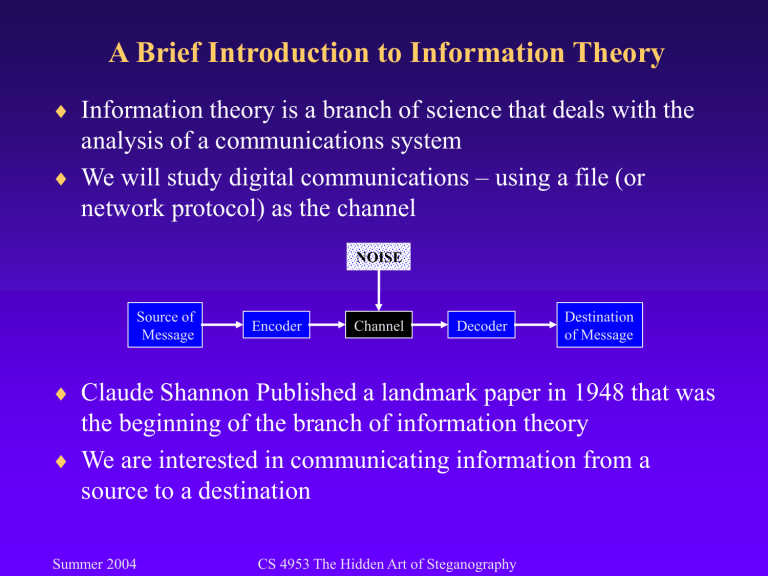
A Brief Introduction to Information Theory
Information theory is a branch of science that deals with the analysis of a communications system
We will study digital communications – using a file (or network protocol) as the channel
NOISE
Source of
Message
Encoder Channel Decoder
Destination of Message
Claude Shannon Published a landmark paper in 1948 that was the beginning of the branch of information theory
We are interested in communicating information from a source to a destination
Summer 2004 CS 4953 The Hidden Art of Steganography
A Brief Introduction to Information Theory
In our case, the messages will be a sequence of binary digits
– Does anyone know the term for a binary digit?
One detail that makes communicating difficult is noise
– noise introduces uncertainty
Suppose I wish to transmit one bit of information what are all of the possibilities?
– tx 0, rx 0 - good
– tx 0, rx 1 - error
– tx 1, rx 0 - error
– tx 1, rx 1 - good
Two of the cases above have errors – this is where probability fits into the picture
In the case of steganography, the “noise” may be due to attacks on the hiding algorithm
Summer 2004 CS 4953 The Hidden Art of Steganography
A Brief Introduction to Information Theory
Claude Shannon introduced the idea of self-information
I ( X j
)
lg
1
P ( X j
)
lg
1
P j
lg P j
Suppose we have an event X, where X i outcome of the event represents a particular
Consider flipping a fair coin, there are two equiprobable outcomes:
– say X
0
= heads, P
0
= 1/2, X
1
= tails, P
1
= 1/2
The amount of self-information for any single result is 1 bit
In other words, the number of bits required to communicate the result of the event is 1 bit
Summer 2004 CS 4953 The Hidden Art of Steganography
A Brief Introduction to Information Theory
When outcomes are equally likely, there is a lot of information in the result
The higher the likelihood of a particular outcome, the less information that outcome conveys
However, if the coin is biased such that it lands with heads up
99% of the time, there is not much information conveyed when we flip the coin and it lands on heads
Summer 2004 CS 4953 The Hidden Art of Steganography
A Brief Introduction to Information Theory
Suppose we have an event X, where X i outcome of the event represents a particular
Consider flipping a coin, however, let’s say there are 3 possible outcomes: heads (P = 0.49), tails (P=0.49), lands on its side (P = 0.02) – (likely MUCH higher than in reality)
– Note: the total probability MUST ALWAYS add up to one
I ( X j
)
lg
1
P ( X j
)
lg
1
P j
lg P j
The amount of self-information for either a head or a tail is
1.02 bits
For landing on its side: 5.6 bits
Summer 2004 CS 4953 The Hidden Art of Steganography
A Brief Introduction to Information Theory
Entropy is the measurement of the average uncertainty of information
– We will skip the proofs and background that leads us to the formula for entropy, but it was derived from required properties
– Also, keep in mind that this is a simplified explanation
H – entropy
P – probability
X – random variable with a discrete set of possible outcomes
– (X
0
, X
1
, X
2
, … X n-1
) where n is the total number of possibilities
Entropy
H ( X )
n j
1
0
P j lg P j
n j
1
0
P j lg
P j
1
Summer 2004 CS 4953 The Hidden Art of Steganography
A Brief Introduction to Information Theory
Entropy is greatest when the probabilities of the outcomes are equal
Let’s consider our fair coin experiment again
The entropy H = ½ lg 2 + ½ lg 2 = 1
Since each outcome has self-information of 1, the average of
2 outcomes is (1+1)/2 = 1
Consider a biased coin, P(H) = 0.98, P(T) = 0.02
H = 0.98 * lg 1/0.98 + 0.02 * lg 1/0.02 =
= 0.98 * 0.029 + 0.02 * 5.643 = 0.0285 + 0.1129 = 0.1414
Summer 2004 CS 4953 The Hidden Art of Steganography
A Brief Introduction to Information Theory
In general, we must estimate the entropy
The estimate depends on our assumptions about about the structure (read pattern) of the source of information
Consider the following sequence:
1 2 3 2 3 4 5 4 5 6 7 8 9 8 9 10
Obtaining the probability from the sequence
– 16 digits, 1, 6, 7, 10 all appear once, the rest appear twice
The entropy H = 3.25 bits
Since there are 16 symbols, we theoretically would need 16 *
3.25 bits to transmit the information
Summer 2004 CS 4953 The Hidden Art of Steganography
A Brief Introduction to Information Theory
Consider the following sequence:
1 2 1 2 4 4 1 2 4 4 4 4 4 4 1 2 4 4 4 4 4 4
Obtaining the probability from the sequence
– 1, 2 four times (4/22), (4/22)
– 4 fourteen times (14/22)
The entropy H = 0.447 + 0.447 + 0.415 = 1.309 bits
Since there are 22 symbols, we theoretically would need 22 *
1.309 = 28.798 (29) bits to transmit the information
However, check the symbols 12, 44
12 appears 4/11 and 44 appears 7/11
H = 0.530 + 0.415 = 0.945 bits
11 * 0.945 = 10.395 (11) bits to tx the info (38 % less!)
We might possibly be able to find patterns with less entropy
Summer 2004 CS 4953 The Hidden Art of Steganography


